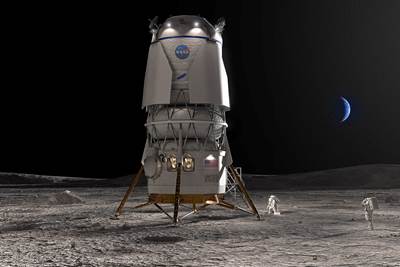Intuitive Machines debuts moon buggy for Artemis program
IM’s Moon RACER is one of three lunar terrain vehicle (LTV) designs being considered by NASA for future operations on the lunar surface.
Fugro Australia’s Space Automation, AI and Robotics Control Complex (SpAARC) entered into agreement with Intuitive Machines to support its LTV phase 1 feasibility contract with NASA. Source |
In line with NASA’s (Washington, D.C., U.S.) selection of Intuitive Machines, Lunar Outpost and Venturi Astrolab to advance lunar terrain vehicle (LTV) development , Intuitive Machines (IM, Houston, Texas, U.S.) unveiled its first prototype at a public debut Nov. 7th at Space Centre Houston. Named the Moon RACER (“Reusable Autonomous Crewed Exploration Rover”), or the “moon buggy,” the pickup truck-sized mock-up highlights how an LTV will be used to travel around the lunar surface for NASA’s Artemis campaign.
Moon RACER is an 8.5-foot-tall, 12-foot-wide autonomous vehicle that is capable of towing a 108-foot-long trailer (33-meter), a key feature that will enable those on the moon to generally transport and operate equipment. According to , “the vehicle can carry two astronauts wearing spacesuits and an additional 400 kilograms of cargo. The trailer can also be connected to the RACER to haul another 800 kilograms.” Alone, the LTV can reach speeds up to 9.3 miles per hour, is capable of climbing or descending 20-degree slopes and driving over obstacles up to 30 centimeters. It will also be equipped with a robot arm for autonomous and manual commanding.
IM has been working with AVL, Boeing, Michelin and Northrop Grumman in competition with teams led by Lunar Outpost and Astrolab. While materials have not been confirmed, it could be assumed that composite materials may play a role in the LTV’s design. For example, during an initial call for LTV solutions in 2021, General Motors and Lockheed Martin of moving away from the previously aluminum rovers of the past to the use of titanium, carbon fiber weave and forged carbon fiber materials to achieve new durability and capability standards. Previous rover designs unrelated to the Artemis program — like the Iris nano-rover developed by Carnegie Mellon University — were also developed using composites.
For related content, read “Type V pressure vessel enables lunar lander”
Should NASA choose IM’s design over Lunar Outpost and Venturi Astrolab, the company will maintain ownership of its lunar rovers. The chosen program will deliver its rover to the lunar south pole and validate its performance and safety ahead of the Artemis V mission .
IM’s Trent Martin, senior vice president for space systems, that “IM is tasked with not only building an LTV, but delivering it to the surface of the moon. So we built a lander that we call the Nova-D. We put the LTV on that lander. We launch it to the moon, and then we operate it on the surface of the moon for 10 years. We operate it when astronauts are driving it. But when they are not there, we will continue to operate the vehicle from here in Houston, from Australia, from the platforms that are on the moon.”
In February 2024, IM achieved a soft landing on the moon with NASA and commercial payloads using its Nova-C lander as one of 14 NASA Commercial Lunar Payload Services (CLPS) mission providers. The Nova-D lander is planned for 2025.
Related Content
ATA Industrial Group report evaluates the state of the global carbon fiber market
Carbon fiber composites market report provides statistics, analyses and trends regarding 2023 demand in China and around the world.
Read MoreECOHYDRO project to enable recyclable composites for hydrogen storage
With the involvement of two schools from the Institut Mines-Télécom, the 4-year project aims to improve the intrinsic properties of a composite material based on Elium via four concrete demonstrators.
Read MoreNatilus announces Horizon blended wing body CFRP aircraft for 200-passenger narrowbody market
Following its Kona cargo aircraft with 460 pre-orders, this larger all-CFRP model responds to airlines’ request to fill Boeing and Airbus gap with 25% less weight, 40% greater capacity and 50% less carbon emissions, to enter service by early 2030s.
Read MorePartners recycle A350 composite production waste into adjustable-length rods for MFFD
Herone, Spiral RTC, Teijin Carbon Europe and Collins Aerospace Almere recycle A350 thermoplastic composite clips/cleats waste into rods for the all-thermoplastic composite Multifunctional Fuselage Demonstrator’s crown.
Read MoreRead Next
On the radar: Reusable launch vehicles, hypersonics make space more accessible
CFRP has become key to targeting efforts in reusing components like rocket stages, as well as the development of reusable hypersonic testbeds and spaceplanes, for increasing space commercialization.
Read MoreNASA selects Blue Origin as second Artemis lunar lander provider
Blue Origin joins SpaceX in design, development, testing and verification of its lander concept to enable recurring astronaut expedients to the moon per the NASA Artemis program.
Read MoreNext-gen fan blades: Hybrid twin RTM, printed sensors, laser shock disassembly
MORPHO project demonstrates blade with 20% faster RTM cure cycle, uses AI-based monitoring for improved maintenance/life cycle management and proves laser shock disassembly for recycling.
Read More












